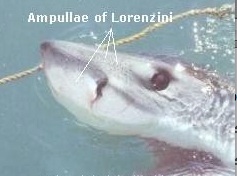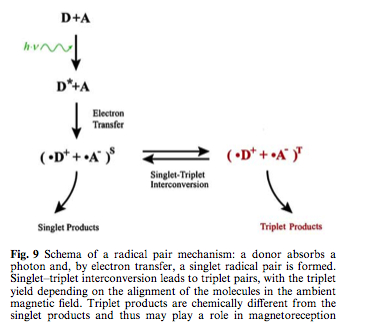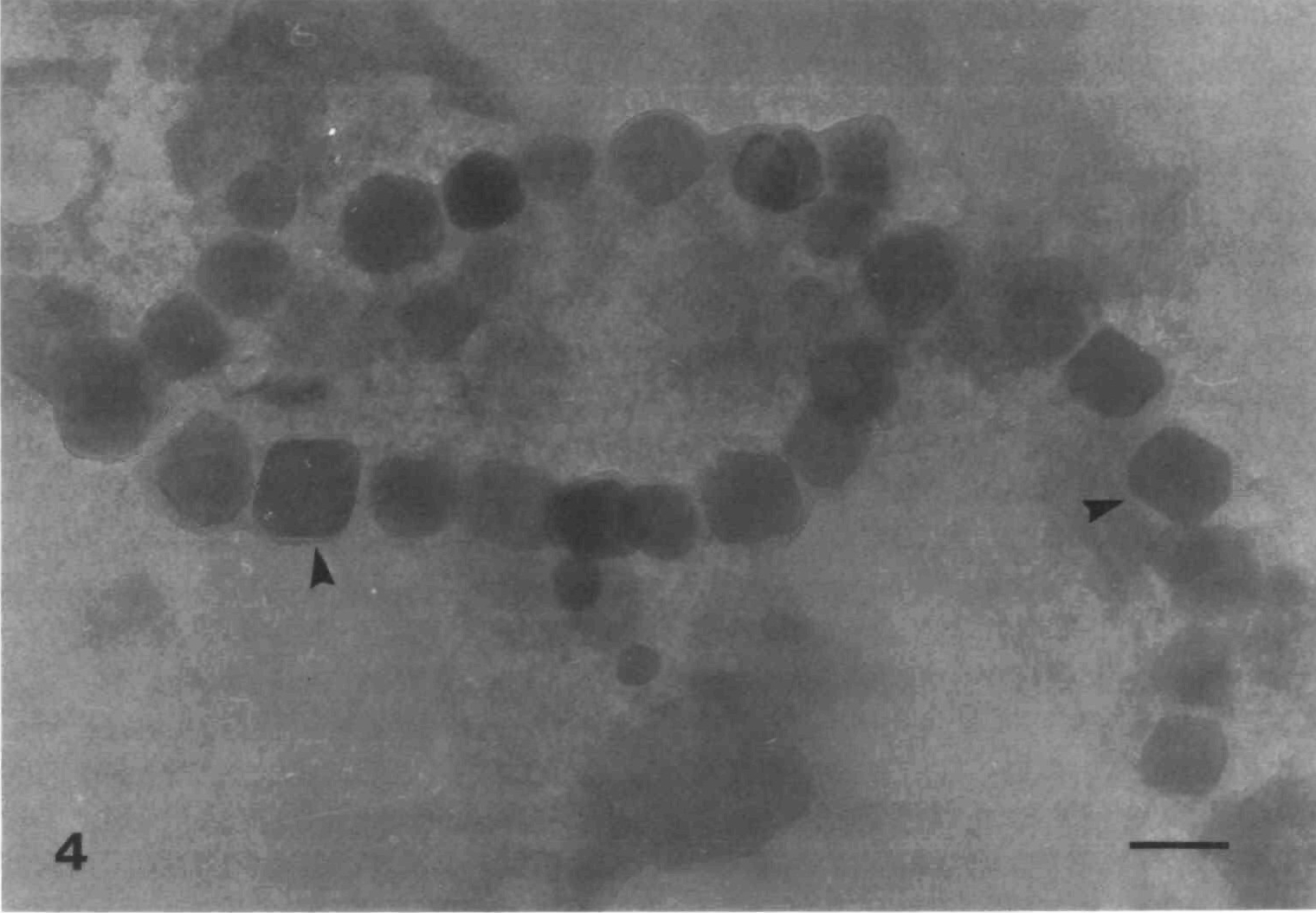Magnetic Orientation Biology 342 Fall 06
Mechanism
Although there is evidence that species from all five vertebrate classes use the earth's magnetic field for navigation purposes, there is very little direct evidence which supports a mechanism for these magnetosensory abilities. Currently, there are three hypotheses that have been proposed which suggest possible mechanisms:- Electromagnetic induction
- Chemical magnetoreception
- Biogenic magnetite
Electromagnetic induction
Electromagnetic induction is most basically the creation of an electrical voltage across a conductor that is located in a magnetic field whose density is changing within a given area. This means that as an electron moves through a magnetic field, it senses a force perpendicular to its motion as well as the field it is moving through. Thus, if a bar magnet, for example, moves through a magnetic field all the electrons will migrate to one side of the bar. If there is a conducting medium which is stationary relative to the magnetic field that connects the two polarized sides of the bar an electric circuit will be created.
Ampullae of a White Shark [12]

Chemical magnetoreception
There is some suggestion that the earth's magnetic field may have an interaction in chemical processes which take place in an organism. This hypothesis is based on the concept of hyperfine coupling. Hyperfine coupling is a way to explain the complex interaction of the magnetic fields created by the electrons and the nuclei of atoms involved in chemical reactions. The energies involved in hyperfine coupling are about the same magnitude as that of the earth's magnetic field, therefore there is the possibility that some disruption could occur.
The theory put forth by Shulten et al. and expanded by Ritz is known as the radical pair reaction scheme, is a reaction between an electron donor, A, and an electron acceptor, B. If A transfers one electron to B, each now contains one unpaired electron, whose spin may be opposite or parallel to the other unpaired electron. Due to the hyperfine coupling experienced from the magnetic field of the spinning nuclei and any external magnetic fields, the rotation axis of the unpaired electron will begin to change, a process known as precession. If the electron is returned from B to A quickly, no change can be perceived. However, if sufficient time elapses(about 100 nanoseconds), the opposite or parallel spin relationship of the electrons will change so that when the electron is returned from B to A, the molecules will be different from their initial states. This change can affect the chemical properties of A and B and can change subsequent reactions that involved these molecules. Despite the fact that there are known chemical reactions that are affected by earth-strength magnetic fields, there are currently no known biomolecular reactions that are affected by such weak fields.
One of the many limitations of this scheme is that the initial process of electron transfer must not randomize the opposite or parallel spin relationship of the two electrons. One case in which the spin relationship is NOT randomized is when the electron transfer is induced by light energy. This suggests that if chemical magnetoreceptors exists, they might also function as photo receptors. Furthermore, if such chemical magnetoreceptive processes do exist in living organisms, in order for them to be functional as a navigational tool, the molecules effected must be fixed in their orientation relative to the animal; the retina, with its ordered array of photoreceptor molecules provides just such a place.
Possible radical pair mechanism [19]

While no direct evidence exists yet which proves this hypothesis, the link between photoreceptors and chemical magnetoreceptors has been explored in both birds and newts. Indirect evidence suggests that the cells of the basal optical root in pigeons can directly detect changes in magnetic fields, and it is these cells which received information from retinal ganglion cells. Other studies done using newts have suggested a link between the pineal gland and magnetoreceptor cells. [6]
Biogenic magnetite
 There has been knowledge of the presence o single-domain magnetite crystals (Fe3O4)
in bacteria for a number of years, and it has prompted the search for
magnetite crystals in other species, as well. Single domain
magnetite crystals acts as permanently magnetized bar magnets that can
rotate to align with an external magnetic field. Presently there are
two hypotheses as to how magnetite transmits information to the nervous
system: one hypothesis suggests that the presence of these
crystals may exert a force on certain nervous system receptors (such as
hair receptors) as they rotate to align with the earth's magnetic field, and the second hypothesis suggests that the crystals may directly open certain ion channels if they are connected to microfilaments
There has been knowledge of the presence o single-domain magnetite crystals (Fe3O4)
in bacteria for a number of years, and it has prompted the search for
magnetite crystals in other species, as well. Single domain
magnetite crystals acts as permanently magnetized bar magnets that can
rotate to align with an external magnetic field. Presently there are
two hypotheses as to how magnetite transmits information to the nervous
system: one hypothesis suggests that the presence of these
crystals may exert a force on certain nervous system receptors (such as
hair receptors) as they rotate to align with the earth's magnetic field, and the second hypothesis suggests that the crystals may directly open certain ion channels if they are connected to microfilamentsChain of magnetic crystals showing characteristic
octahedral morphologies. Scale bar, 50nm [5]
So far magnetite crystals have been found in magnetotactic bacteria, honeybees, trout and a few species of migratory birds. Studies done using trout have traced the path of magnetically responsive nerves to an area in the nose which was shown to contain magnetite crystals. This close association of the magnetically responsive nerve and the possible magnetic receptor cells suggests that electrophysiological responses to magnetic fields and these receptor cells may be functionally linked [5,14]. Further, neurological studies have been done using a species of mollusc which have identified six neurons that are sensitive to earth-strength magnetic fields. Molluscs are ideal organisms for these types of studies because they have a very simple nervous system, and the nerves which have been shown to either respond to magnetic fields or be inhibited by magnetic fields have also been shown to connect directly to the "foot" of the mollusc, providing a possible way in which the mollusc can then generate a physical response to the sensed magnetic field [2, 20, 21].
The six neurons found to be sensitive to
earth-strength magnetic fields in Tritonia diomedea [21]
earth-strength magnetic fields in Tritonia diomedea [21]
